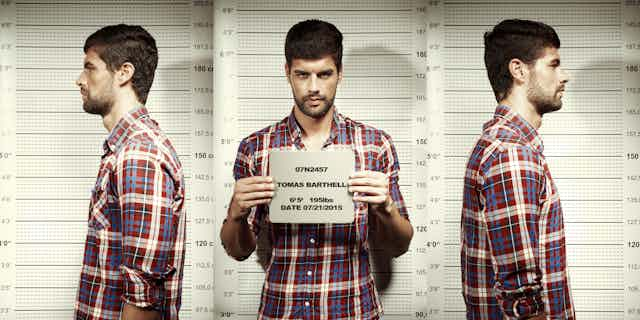Ted Bundy was suspected of a string of kidnappings, rapes, and murders in the US. Police placed him in a lineup to see if an eyewitness to kidnappings in the Lake Sammamish area near Seattle would identify him. She did not – and Bundy was freed to continue his killing spree, murdering at least a dozen more women before he was finally convicted and executed.
Ronald Cotton was another US police suspect of a rape. He was placed in a lineup and identified by the victim, Jennifer Thompson-Cannino, as the perpetrator. But Cotton was innocent. He spent 10 years in prison before he was exonerated thanks to DNA evidence.
Thousands of suspects have been convicted based on identifications made from lineup procedures. But these examples show the serious consequences when witnesses make mistakes. This means that it is vital that lineups are carried out in the most effective way possible. To help us learn what makes an effective lineup procedure, my colleagues and I have studied how the practice differs in the US and the UK. While the above examples from the US show that mistakes do happen, we found that participants acting as witnesses who were shown a US-style lineup were more likely to correctly identify the perpetrator and had higher confidence in their decision.
In typical police lineups, the victim or eyewitness of a crime is asked to identify the perpetrator from images of several people (and no longer from a physical live lineup as often portrayed in TV and film). This includes the police suspect –- who may or may not be the actual perpetrator – and other people who are known to be uninvolved in the crime, known as “fillers”.
Sometimes the witness makes a mistake. If the witness identifies one of the fillers, it’s not a costly error because the police know they are innocent. But if the police suspect the perpetrator and the witness fails to identify them then they could walk free (as in the case of Ted Bundy). This is known as a “miss”. The witness could also falsely identify the police suspect as the perpetrator when they are really innocent (as in the case of Ronald Cotton).
Both of these errors are costly, so the more police can use lineup procedures that increase discriminability, the better. Discriminability is the ability of an eyewitness to sort guilty from innocent suspects. The best lineup procedure is one that has better discriminability than other procedures.
A confident witness is (usually) reliable
Another important consideration is the reliability of an identification. That is, how likely it is that the identified person is indeed the perpetrator. How confident an eyewitness is in their identification is an indication of how accurate they are, and so how reliable they are. A highly confident eyewitness is more likely to be accurate than an eyewitness who is uncertain in their identification. It is critical to note that confidence is only meaningful at first identification, not later in a trial when memory can been influenced by other factors.
In the US, the most common lineups involve photos of six people including the suspect. All lineup members are photographed from the shoulders up to show the front view of the face. The photos are all shown at the same time. The eyewitness can pick a lineup member or not pick anyone.
In England and Wales, the standard lineup procedure is to use videos of nine people including the suspect. Each lineup member is filmed facing forward, turning to the right and to the left to show profile views, and then turning to the front again. The videos, which last approximately 15 seconds each, are shown one after the other. The eyewitness must watch the nine videos twice before they either pick a lineup member or not pick anyone.
To determine which lineup is better, we showed over 2,000 participants a video of a mock crime in which an actor played the perpetrator stealing money from a vacated office. A London Metropolitan Police Officer trained in identification procedures chose the fillers from their database and filmed the actor. We then asked participants to try to pick the perpetrator from a US- or UK-style lineup and rated their confidence.
US style better in both ways
Those who had to pick the perpetrator from the US-style photo lineup were better at identifying the guilty suspect and not identifying an innocent. In other words, false identifications and misses occurred more often for the participants who had to pick the perpetrator from the UK-style lineup. So the US lineups yielded greater discriminability than the UK lineups.
Our research confirmed that participants who were highly confident were more likely to have correctly identified the perpetrator – and that participants who made identifications with a low level of confidence were more likely to be incorrect. But we also found that participants who were tested on the US-style lineup were more accurate at all confidence levels compared to those tested on the UK lineup. So the US lineups also yielded greater reliability than the UK lineups.
Because there are many differences between the two lineups, we can’t yet say why the US lineup performed better. What is clear is that there is much room for improvement for the UK lineup. We currently have research underway to investigate how to make UK lineups better by studying the different factors that could affect discriminability. Research along these lines should lead to fewer miscarriages of justice.

